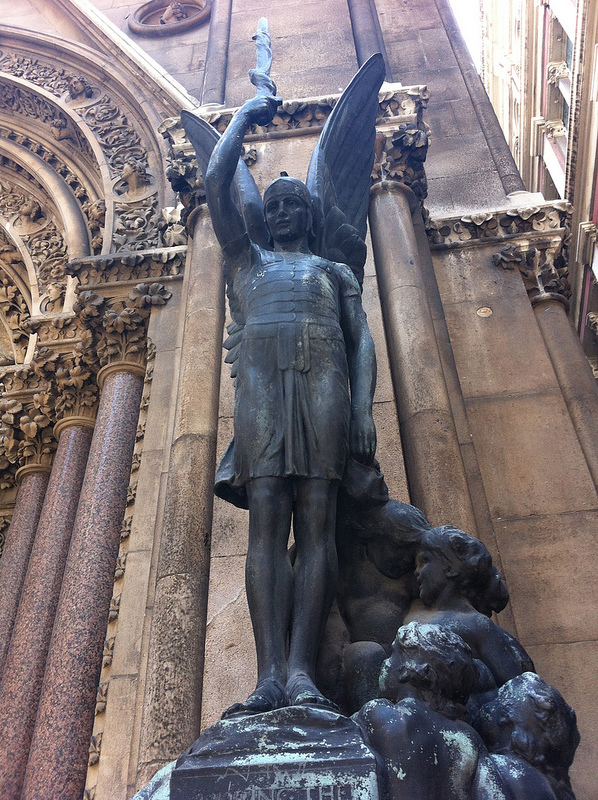
Every so often as a reader, I find these types of posts useful so I wanted to provide one here. This post merely presents the online resources I use to support my mobile learning in London. These aggregate to my research toolkit. They are presented below loosely grouped, perhaps, by media. All are freely available. I rarely, if ever, use materials for this type of learning that are behind paywalls. I am bound to do so in my doctoral research, but I don’t find it necessary for this type of research.
A quick note on the context of learning I am referring to
The type of learning that these online materials support is the kind I describe endlessly on this blog and in my book. It is the kind that is not aligned with any particular curriculum or formal mode of study. It is just me taking my daily walk and seeing something that piques my interest. I record media, location, even the occasional bits of additional metadata. I upload that data to my respective services (social media or otherwise) and return home to research more. I try to contextualize the location where I found that initial interesting artifact. I try to understand the layers of historical activity that are influencing the reality of this place at this time. These are the mobile learning field activities I refer to often on this site.
The sources presented here let me ‘triangulate’ my initial findings of interesting things with primary source data. It lets me build small understandings of time and space intersections; it gives life to the environment historically. So when I return to this original location (as I always do as I can only walk so far any given day), I have a more enriched understanding of this place as it is and as it was. This is mobile learning to me, a space and mindset transformed. So here are the resources I use to enact that transformation.
The Resources
Note: these resources are listed with the link embedded and with little to no explanation. I expand on how a few of them might be used in the subsequent section. All are freely available (at least at the time of this writing) and all are incredibly rich with detail and discovery, not unlike the city itself.
- British History Online
- Connected Histories: British Sources 1500-1900
- London Lives: Crime, Policy, Social Policy in the Metropolis
- Locating London’s Past: maps all results on the beautiful John Rocque’s 1746 map.
- Museum of London Collections
- Institute of Historical Research at the University of London
- London Metropolitan Archives
- National Archives
- Charles Booth Online Archive, London School of Economics
- London Gazette
- The British Newspaper Archive
- The Times Archive
- London Sound Survey
- British Library Sounds
- British Library Digitized Manuscripts
- Bishopsgate Institute: (some photography, magazines, ephemera)
- British Film Institute Archives
- Old Bailey Online (legal proceedings)
The Learning Opportunities
I could go on endlessly about the possible combinations that exist here for teachers wanting to do some historical field activities with mobile technology. I tend to think of these activities as perfect illustrations of disciplinary practice in history, on how findings are made (in the field or through other research), knowledge claims are advanced, and these same claims are then validated (or not) through the use of primary and secondary sources. So, from a strict disciplinary and formal learning perspective, teachers can consider any of these, all chronicling place from a different perspective:
- Sociology (and Law): use the Old Bailey resources to see criminal activities in a particular space over a course of time (my street, Minories, was seemingly chock-a-block full of criminal and nefarious activity). Compare that insalubrious past to its current manifestation and former social policy (from London Lives). Match these Old Bailey legal proceedings with newspaper or gazette articles on activity on that same street over a course of time. Look for images, drawings, and paintings to support an eventual composition for your students demonstrating the living history of that space.
- Sounds, Images, and Film: use the London Sound Survey (incredible resource), the British Library Sounds collection, the British Film Institute Archives, and your own recorded media (from the mobile field activity) to construct a multimedia composition of the place from both then and now. Critique the sound quality of a place, the levels of traffic, the seeming pollution (the BFI archives have a lot of old film clippings of particular locations).
- Construct Layered Histories: find evidence of activity in a particular location (Leadenhall, for example) across the layers of London history, namely Roman, Saxon, Norman, and modern. Have your students place this evidence and their own recoded media on a map or a timeline of a place to demonstrate the layers of activity that have occurred on this same spot.
There are endless variations of these (I cannot tell you how many I have concocted in my own head), but the most important thing to remember is that there is literally nothing stopping you from performing some of these activities with your own learners or even on your own. The technology is readily available (mostly), the locations are begging to be investigated, and most of the research you need is available freely online. Particularly in large cities like London, New York, Paris, etc. all the raw materials for serendipitous and intentional learning exist. You have the opportunity to expand your teaching repertoire, your resource and mobile toolkits, and your learners will hone their capacity for meaning-making in fluid contexts, in disciplinary spaces, and in and around space.

[…] Every so often as a reader, I find these types of posts… […]
[…] Every so often as a reader, I find these types of posts… […]